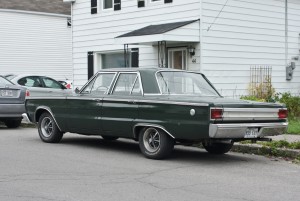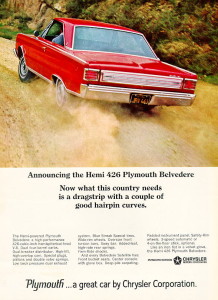Call it a sleeper.
When people think of 1960s Chrysler Corporation collectibles, the mind usually turns (almost exclusively) to the years 1968 and ’69, and the hot muscle cars cranked out by Dodge and Plymouth.
Brash, in-your-face, and often sporting vivid colours to alert cops from afar, those rides oozed appeal but they aren’t – oh, what’s the word – subtle.
Go back a few years further, and you’d find there was still muscle to be had, only with a side of anonymity.
The 1966 Plymouth Belvedere is a good example of that – a car that could drag race on a country road but wouldn’t appear out of place in a church parking lot.
The Belvedere was Plymouth’s bread and butter midsize, sandwiched between the compact Valiant and the full-size Fury.
Spanning a number of body styles, the Belvedere line included the Belvedere I and II trim levels, as well as the top-level Belvedere Satellite, available only as a two door.
After spending the early 1960s in a state of confusion trying to figure out its styling direction, Chrysler Corp. entered 1966 with a firm commitment to the slab-sided look, which adorned everything from lowly Plymouths to top-end Imperials.
The razor-edged styling motif, which served to emphasize the vehicles’ length, continued until the Fuselage Era of 1969-1974.
1966 was also the year Chrysler began hitting the gym and showing off.
The fastback Plymouth Barracuda and Dodge Charger bowed that year, the latter backed by a youth-oriented ‘Dodge Rebellion’ advertising campaign.
The corporation capitalized on the success of its vehicles – including the Belvedere – in the hands of NASCAR drivers like Richard Petty, inserting those wins into ad material to bolster its growing street cred.
Midsizers often prove to be versatile vehicles, and the Belvedere was eager to be anything its owner wanted it to be.
With a 225 c.i.d. Slant-Six serving as a base engine, the Belvedere could be equipped with a vast array of V-8s. A 273 c.i.d. with 180 hp, a 318 with 230hp, a 361 with 265 hp, and a Commando 383 with 325 hp were available, as was the range-topping 426 Plymouth Street Hemi.
That engine, introduced in 1966, made 425 horsepower and 490 ft-lbs of torque. When coupled with the Belvedere’s fairly light midsize body, the engine was a performance monster.
The Belvedere spotted here sported ‘383’ badges and the popular and bulletproof 3-speed TorqueFlite automatic. No doubt it could lay some rubber in a hurry. But, if you were to take away the white letter tires and sport rims, there’d be little to give away this car’s performance secret.
In a word: discreet.



